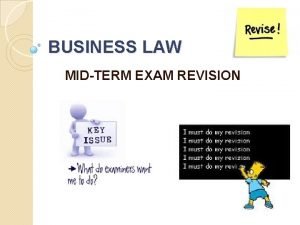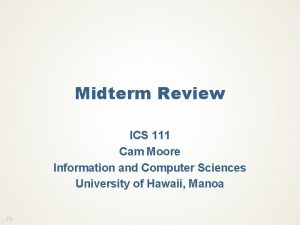Class Seven Part One Midterm Review Classes One

































































- Slides: 65

Class Seven – Part One: Midterm Review Classes One to Six


Last Time We Spoke About: • Corporations - 1. Types of corporations - 2. Pre-incorporation - 3. Formation Corporations - 4. Property of Corporations - 5. Powers of Corporations

Tonight We Will Speak About: • Midterm Review • Corporations Continued - 1. Types of corporations - 2. Pre-incorporation - 3. Formation Corporations - 4. Property of Corporations - 5. Powers of Corporations

Midterm Review – Looking back – Looking forward

Part One: • General Principals:

• And so, What is the “Law”? • The “Law” has been defined by Black’s Law Dictionary as follows: • • “That which is laid down, ordained, or established. A rule or method according to which a phenomena or actions co-exist or follow each other. Law, in its generic sense, is a body of rules of action or conduct proscribed by controlling authority, and having binding legal force. … Law is a solemn expression of the will of the supreme power of the state. ” • Perhaps the simplest description of the Law, however, is that: “Law is the Rules by which civilization is ordered. ”

The Chief Elements / Components of the Law are: 1. Rules 2. Pronounced, laid down and/or issued by a controlling authority; 3. That are consistent and lasting; and 4. That are enforceable and followed by the governed. • Early laws were simply directives from a king or sovereign.

Modern Laws Include: Ø Constitutions: Both Federal and State Ø Statutes: Enacted by Elected Legislative Bodies (Such as Congress or State Legislature) Ø Case Law: Also known as “The Common Law” (Case Decisions delivered by Courts) Ø Regulations: Promulgated by government (Executive) agencies (Agency pronouncements designed to amplify or clarify their authority as provided in statute or constitution) Ø Executive Orders: Issued by Executive (President or Governor) (Instructions by the Executive to their agencies directing them how to execute a procedure or law)

As a result of this representative, federal, republic: Laws are made pursuant to the following construct: Federal Government (For All National Laws – Supreme but Limited Powers) President (Executive) Congress (Legislative) Federal Courts (Judicial) State Government (For All State Laws – Subservient but Unlimited Powers) Governor (Executive) State Legislature (Legislative) State Courts (Judicial)

Federal Government (Separation of Powers and Checks and Balances) President (Executive) Congress (Legislative) Federal Courts (Judicial) Supreme Court US Senate US House of Representatives US Court of Appeals US District Court

State Government (Pursuant to State Constitution – Similar Checks and Balances) Governor (Executive) State Legislature (Legislative) State Courts (Judicial) NYS Court of Appeals NYS Senate NYS Assembly Appellate Division of NYS Supreme Court

Priority of Laws: 1. Constitution: Established by Convention of Elected Delegates to provide governmental framework and protections of individual rights, they are supreme to all other laws as interpreted by the Courts 2. Statute: Laws passed (enacted) by an elected legislative body (Congress or State Legislature) and signed into law by the Executive (President or Governor). 3. Regulation: Promulgated by government (Executive) agencies to amplify or clarify their authority as provided in statute or constitution. 4. Executive Order: Issued by Executive (President or Governor) as an instruction to their agencies on how to execute a procedure or law. v Case Law or Common Law Decisions issued by courts which provide legal rules by: 1. Interpretation of a Constitution, Statute, Regulation or Executive Order, or 2. Clarifying or creating law pursuant to past court decisions.

This is a class on the Law of Business Organizations One can not have a true understanding the Law of Business and the Organizations which are its vehicle to accomplish its goals, unless they have a true understanding of the Law. Moreover to truly understand the Law of Business, we need to understand these Organizations as the vehicle which delivers the needs of Commerce. That requires us to have an understanding of the Law which governs the rules of the road upon which we drive that vehicle.

The Law of Business Organizations is mostly state law So we will concentrate our travels on the legal roads of New York State

Part Two: • The Law of Agency:

Black's Law Dictionary – 8 th Edition (Thompson West 1999) Defines the term Agency as follows: • “A fiduciary relationship created by express or implied contract or by law, in which one party (the agent) may act on behalf of another party (the principal) and bind that other party by words or actions. ” Ok… What does this tell us?

The Elements of the Agency Relationship: 1. A fiduciary relationship 2. Created: a. by express contract; b. by implied contract; or c. by law, 3. In which one party (the agent) may act 4. On behalf of another party (the principal) 5. and bind such principal (via their authority) 6. by words or actions

Agency In General – Contract Liability Contract liability in agency refers to the legal relationship whereby one party (called an agent) is authorized to represent the other party (called a principal) in business dealings with third parties. A principal may appoint an agent to do any act EXCEPT an act by its nature, by public policy, or by contract, that requires personal performance by the principal.

CREATION OF THE AGENCY RELATIONSHIP Continued: 1. Capacity: A condition precedent to the creation of an agency relationship is that the respective parties must have capacity. a. Principal Must Have Contractual Capacity Generally, one who has contractual capacity may be a principal and enter into a contract through an agent. b. Agents Generally Need Not Have Contractual Capacity As a general rule, any person may be an agent, even if they have no contractual capacity. But there are limitations to this rule. c. Disqualification of Agents A person, however, can be disqualified from being an agent.

CREATION OF THE AGENCY RELATIONSHIP Continued: 1. Capacity Continued: a. Principals: Must Have Contractual Capacity Generally, one who has contractual capacity may be a principal and enter into a contract through an agent. 1) Minors As a general rule, a minor cannot bind himself absolutely in contract; therefore, his appointment of an agent as well as the agent's actions are voidable and can be disaffirmed. - Minors in Entertainment Industry Contracts made by those dealing with infants in the entertainment industry are subject to two conditions: (1) The contract may be guaranteed against disaffirmance if prior judicial approval is obtained. [N. Y. S. Arts & Cultural Affairs Law § 35. 03] (2) If judicial approval was not obtained, the contract may be enforceable, but resolution of enforceability must await an attempt to disaffirm, and contract must contain standard in the trade, was reasonable, and there was no claim of fraud.

CREATION OF THE AGENCY RELATIONSHIP Continued: 1. Capacity Continued: a. Principals: Must Have Contractual Capacity Generally, one who has contractual capacity may be a principal and enter into a contract through an agent. 2) Incompetents An incompetent's appointment of an agent as well as the agent's actions may be disaffirmed by the incompetent or his committee or personal representative. 3) Unincorporated Organizations Unincorporated not-for-profit organizations such as churches and clubs CANNOT be principals. - However, members of such organizations may be held jointly liable as principals if they have authorized or assented to the act giving rise to the litigation.

CREATION OF THE AGENCY RELATIONSHIP Continued: 2. Formalities a. Consent As the relationship is a contract, consent must be manifested by both the principal and the agent to create an agency relationship. b. No Consideration Required Unlike a standard contract, however, consideration is not necessary for the creation of an agency relationship. c. Writing – No Written Contract Required 1. General Rule-No Writing Required Another exception to this contractual relationship is that normally, the existence of the agency DOES NOT have to be evidenced by a writing. Note: This is true even where the Statute of Frauds requires the agreement that the agent is entering on behalf of the principal to be in writing. 2. Conveyance of Real Estate An exception to this exception, however is where a party relying on a written contract of sale of an interest in realty greater than one year must show that the agent's authority to sign was in writing or that the principal has ratified the signing. [See N. Y. S. General Obligations Law § 5 -703, § 5 -1111]

CREATION OF THE AGENCY RELATIONSHIP Continued: 3. Modes of Creation of the Agency Relationship a. By Act of the Parties 1. Actual Authority 2. Apparent Authority 3. Inherent Authority 4. Ratification b. By Operation of Law 1. Estoppel 2. Statute

CREATION OF THE AGENCY RELATIONSHIP Continued: 3. Modes of Creation of the Agency Relationship a. By Act of the Parties There are four ways in which the parties may create an agency relationship. They are as follows: 1. Actual Authority The principal may, by direct communication to the agent, orally or in writing, actually appoint and authorize the agent to act on the principal's behalf. 2. Apparent Authority The principal may, by communication to the third party, orally or in writing, indirectly authorize the agent to act on the principal’s behalf. 3. Inherent Authority The principal, by actually authorizing the agent to act, may be liable for acts performed by the agent, even if such acts are in violation of the principal's orders. 4. Ratification An agency relationship may be created by the principal's later, subsequent affirmation (ratification) of the actions of one who purported to be acting on behalf of the principal. Basically, a ratification affirms a previously unauthorized act.

CREATION OF THE AGENCY RELATIONSHIP Continued: 3. Modes of Creation of the Agency Relationship b. By Operation of Law Under certain circumstances, the law may impose an agency relationship. They are as follows: 1. Estoppel In certain instances, the law may impose an agency relationship under the doctrine known as estoppel. Under these circumstances the principal is legally estopped from denying the existence of the agency under a theory of equitable relief. Note: There is little difference recognized in law between estoppel and apparent authority as they both depend on a third person's reliance on a communication from the principal. The former is merely an equitable remedy to prevent unjust enrichment, while the latter gives rise to a contract with its accompanying rights and obligations. 2. Statute In other instances an agency may be created by statute. Such statutes are usually, however, designed to accomplish or address a limited purpose. Example: Certain statutes will designate the Secretary of State as an agent for the limited purpose of receiving service of process. [See N. Y. S. Vehicle and Traffic Law § 2531]

TYPES OF AGENCY AUTHORITY Continued 1. Actual Authority Continued B. Termination of Actual Authority Once having determined that the requisite formalities exist and that there is express or implied actual authority, you should ask whether the authority has been terminated. Termination of actual authority may occur in the following ways: 1) By Lapse of Time a) Specified Time b) Time Not Specified 2) By Happening of Event 3) By Breach of Agent's Fiduciary Duty 4) By Change of Circumstances a) Destruction of the subject matter of the authority; b) A drastic change in business conditions; c) A change in relevant laws; and d) Insolvency of the agent or principal, if relevant. 5) By Unilateral Act of Principal or Agent 6) By Operation of Law a) Death b) Incapacity of Principal c) Dissolution of Corporation or Partnership

TYPES OF AGENCY AUTHORITY Continued 1. Actual Authority Continued C. Irrevocable Agencies There are two types of agencies that may not be unilaterally terminated by the principal: - Subject Matter: where the agent has an interest in the subject matter of the agency, - Security: Where the agent has a power given for security. 1. Definitions a) Agency Coupled with an Interest b) Power Given as Security c) Agency Status 2. Restatement View a) Purpose of Grant b) Consideration.

TYPES OF AGENCY AUTHORITY Continued 1. Actual Authority Continued C. Irrevocable Agencies Continued There are two types of agencies that may not be unilaterally terminated by the principal: - Subject Matter: where the agent has an interest in the subject matter of the agency, - Security: Where the agent has a power given for security. 1. Definitions a) Agency Coupled with an Interest This is where an agent has an "interest" when she has been given immediately exercisable rights in the property. Note: Dawn owes Edgar $20, 000. Dawn gives Edgar a written power of attorney authorizing Edgar to sell her farm Black Rock, and to remit to Dawn any money received in excess of $20, 000. Edgar accepts this as a discharge of Dawn’s debt. Dawn cannot revoke Edgar's power to sell Black Rock. b ) Power Given as Security A power given as security is normally exercisable by the agent only upon a subsequent default by the principal. These transactions normally involve a loan to the principal with the principal posting collateral and giving the agent authority to sell in the event of a default. Note: Powers given as security involve a principal-agent relationship where the agent is really acting for their own benefit. Therefore, even though agency is involved, the agent has their own interest in the subject matter of the agency power. c) Agency Status Strictly speaking, the above are not agencies at all because the first is technically an assignment for purposes of securing a loan, and in the second the agent is not acting under the control of the principal or for the principal, but as the principal where default occurs. In addition, unlike other agency relationships, these do not terminate by operation of law.

TYPES OF AGENCY AUTHORITY Continued 2. Apparent Authority Continued A. Apparent Authority (a/k/a as Ostensible Authority) Continued: a. Basic Theory Continued 1. "Holding Out" by Principal a) Affirmative Action The "holding out" may be by word or conduct on the part of the principal. Note: Pat tells Tom that Anne is Pat's agent and has the power to contract for Pat. In fact, Anne has no actual authority to contract for Pat. If Anne contracts with Tom on Pat's behalf, then Pat will be bound under the doctrine of apparent authority. b) Inaction The "holding out" may also be by inaction on the part of the principal. Accordingly, when it comes to agency, there must be some duty to act, (i. e. , to disclose) or apparent authority will attach. Note: Anne, in Pat's presence, tells Tom that she is Pat's agent when in fact she is not. Under these circumstances, Pat has a duty to correct A's representation; if he does not, Anne will have apparent authority to act on Pat's behalf. 2. Reasonable Reliance by Third Party In addition to the requirement that some "holding out" must be traceable to the principal, the third party must reasonably rely on the "holding out. " Note: Payment to the attorney for a claimant after settlement or judgment discharges the debtor's obligation. The attorney has at least apparent authority to collect. If the attorney absconds with the money, his client may not thereafter compel the debtor to pay a second time.

TYPES OF AGENCY AUTHORITY Continued 3. Ratification A. Generally There are situations where an individual Prospective Agent will purport to act on behalf of a Prospective Principal without any type of authority. In such a situation, may still be bound by such Prospective Agent’s act if such Prospective Principal subsequently ratifies such Prospective Agent's act. 2. What Constitutes Ratification a. Prerequisites 1) The Prospective Principal Must Know Material Facts There can be ratification only where the Prospective Principal has or reasonably should have knowledge of the material facts at the time of the alleged affirmance. . 2) The Prospective Principal Must Accept Entire Transaction Ratification must be of the entire transaction. The Prospective Principal may not merely ratify a portion of the transaction (unless, of course, the transaction[s] is severable). 3) The Prospective Principal Must Have Capacity The Prospective Principal must be competent and of legal age in order to ratify. 4) No Consideration Needed Ratification is a unilateral act of the Prospective Principal and requires no consideration.

TYPES OF AGENCY AUTHORITY Continued 3. Ratification A. Generally There are situations where an individual Prospective Agent will purport to act on behalf of a Prospective Principal without any type of authority. In such a situation, may still be bound by such Prospective Agent’s act if such Prospective Principal subsequently ratifies such Prospective Agent's act. 3. What May Be Ratified a. General Rule Anything a Prospective Principal could have legally done can be ratified. Accordingly, as long as a Prospective Agent’s act could have legally been performed or authorized by a Prospective Principal at the time a Prospective Agent acted, then the Prospective Principal may ratify. Note: On June 1, Prospective Agent, without any authorization, contracts on Prospective Principal's behalf to establish an off-track betting parlor. On July 1, the legislature legalizes off-track betting. Prospective Principal may not ratify after July 1 because Prospective Agent’ s original act was illegal. b. Exceptions 1) Performance Illegal If contract performance would be illegal at the time of the ratification, it may not be ratified. Note: Assume same off-track betting example as above, except that offtrack betting was legal on June 1 and outlawed on July 1. Accordingly, the Prospective Principal may not ratify after July 1. 2) Withdrawal by Third Party If, prior to ratification, the third party indicates that she will not be bound by the contract, the Prospective Principal may not ratify. 3) Material Change of Circumstances Where there has been a material change of circumstances so that it would not be equitable to hold the third party to the contract, there can be no ratification. Note: Prospective Agent sells Prospective Principal’s house to Ken. Before ratification, the house is destroyed by fire. Prospective Principal may not ratify.

TYPES OF AGENCY AUTHORITY Continued 3. Ratification A. Generally There are situations where an individual Prospective Agent will purport to act on behalf of a Prospective Principal without any type of authority. In such a situation, may still be bound by such Prospective Agent’s act if such Prospective Principal subsequently ratifies such Prospective Agent's act. 4. Who May Ratify a. General Rule The general rule is that a Prospective Principal alone can ratify. A Prospective Principal may not elect to treat the contract as her own. Note: On June 1, Prospective Agent Art, without any authorization, contracts on Prospective Principal Paul's behalf to establish an off-track betting parlor. On July 1, the legislature legalizes off-track betting. Paul may not ratify after July 1 because Art’s original act was illegal. b. No Ratification by Undisclosed Principal Because the act must be entered into by Prospective Agent Alex on behalf of Prospective Principal Pam, an undisclosed principal cannot ratify because third party never relied upon her existence. (Compare with ratification in tort situations, however. There it is not necessary that the third party have knowledge of Pam as long as Alex intended to act on his behalf. )

THE AGENCY RELATIONSHIP Continued 4. Rights and Duties Between Principal and Agent: A. What is Duty a. Duty Defined: Black’s Law Dictionary defines “DUTY” as: 1. A person’s action which is exactly conformable to the laws which require the person to obey them; or 2. A legal or moral obligation; or 3. Conduct or service which is obligatory; or 4. A mandatory obligation to perform. b. Simple definition of “Duty”: “A legally recognized obligation requiring certain conduct by one person to another. ”

THE AGENCY RELATIONSHIP Continued 4. Rights and Duties Between Principal and Agent Continued: B. Duties of Agent to Principal The agent has whatever duties are expressly stated in their contract with their principal. Additionally, in the absence of anything contrary in the agreement, the agent has three major duties implied by law: loyalty, obedience, and care. a. Duty of Loyalty The fiduciary duty of an agent to his principal is one of undivided loyalty. If an agent has interests adverse to the interests of his principal (e. g. , self-dealing or obtaining secret profits), then such agent will be seen as in breach this duty by failing to disclose. b. Duty of Obedience 1 General Rule An agent must obey all reasonable directions of his principal. While the principal may well be liable for the agent's acts in violation of directions (apparent or inherent authority), the agent will be liable to the principal for any loss that the principal suffers. 2. What Constitutes Reasonable Directions Reasonableness depends on custom, the nature of the work, and contractual understanding. Example: A janitor would be expected to follow minute instructions regarding his daily work effort while an attorney would not normally be expected to follow his client's directions as to how to draft a complaint.

THE AGENCY RELATIONSHIP Continued 4. Rights and Duties Between Principal and Agent Continued: B. Duties of Agent to Principal Continued The agent has whatever duties are expressly stated in their contract with their principal. Additionally, in the absence of anything contrary in the agreement, the agent has three major duties implied by law: loyalty, obedience, and care. c. Duty of Reasonable Care 1. Compensated Agent An agent owes a duty to his principal to carry out his agency with reasonable care, in light of local community standards and taking into account any special skills of the agent. 2. Gratuitous Agent The modem trend is to hold a gratuitous or uncompensated agent to the degree of care customary in the community for one undertaking similar tasks without compensation. In most situations, this results in no difference between the standard for paid and unpaid agents. 3. Duty to Notify An agent has a duty to notify his principal of all matters that come to the agent's knowledge affecting the subject of the agency. The effect of this rule is that notice of all such matters coming to the attention of the agent is imputed to the principal. Example: Notice will not be imputed under certain circumstances, e. g. , where the agent acts in their own interest and adversely to the principal, or where the agent and the third party attempt to commit a fraud on the principal.

THE EMPLOYMENT RELATIONSHIP 1. EMPLOYMENT: A. What is Employment a. Employment Defined: Black’s Law Dictionary defines “Employment” as: 1. Act of employing or state of being employed; or 2. That which engages or occupies; or 3. That which consumes time or attention; or 4. An occupation, profession, trade, post or business. b. Simple definition of “Employment” is: “An act to engage or hire one’s service, in return for payment for such service. ” c. Labor Law Definition: A relationship where someone is “permitted or suffered to work”

THE EMPLOYMENT RELATIONSHIP 1. EMPLOYMENT: B. Employment v. Independent Contractor 1. The Employer- Employee Relationship a. Definitional Standards 1. Independent Contractor A clear example of an independent contractor is one who has a calling of his own, is hired to do a particular job, is paid a given amount for that job, and who follows his own discretion in carrying out the job. A principal has no right to control the manner and method in which an independent contractor performs the job. 2. Employee A clear example of an employee is one who works full-time for his employer, is compensated on a time basis, and is subject to the supervision of the principal in the details of his work. An employer has the right to control the manner and method in which an employee performs the job. b. Determination of Right to Control There are many cases where it is not clear whether the relationship is one of employeremployee or principal-independent contractor. The single overriding factor in determining whether a person is an employee is whether the principal (employer) has the right to control the manner and method by which the individual performs his tasks.

THE EMPLOYMENT RELATIONSHIP 1. EMPLOYMENT: C. Employment at Will v. Employment Contract 1. Employment at Will Concept New York State is an Employment at Will state. This means that an employer can pay the employee what they wish (so long as it is above minimum wage), provide what benefits (if any) that they wish, and dismiss (fire) an employee for any reason or no reason as long as it is not an illegal reason (such as a violation of the Federal Civil Rights law or New York State Human Rights law). 2. Employment Contract An exception to the employment of will doctrine is where the employee and employer have an employment contract. In such instance the contract terms will govern the parameters of the employment. A collectively bargained employee is determined to have an employment contract as negotiated and approved by the employer and the employee’s representative (union). 3. When it is unclear if there is an Employment Contract Under certain circumstances whether an employment contact exists can be unclear. Under such circumstances, courts have imposed other documents (such as an employee manual) to constitute an employment contract.

THE EMPLOYMENT RELATIONSHIP 1. EMPLOYMENT: C. Employment Regulation 1. Equal Opportunity a A. Federal Civil Rights Law: Federal Civil Rights Law Prohibit Employment Discrimination on the basis of race, color, religion, sex, or national origin, age, gender, disability and pregnancy. Such discrimination can be contested by means of a civil action under 42 U. S. C. Section 1983. B. State Human Rights Law Section 290 of the NYS Executive Law provides that the “opportunity to obtain employment without discrimination because of age, race, creed, color, national origin, sexual orientation, military status, sex, marital status, or disability, is hereby recognized as and declared to be civil right. ” Such rights can be enforced through both civil and governmental actions. 2. Collective Bargaining A. National Labor Relations Act The National Labor Relations Act (Wagner Act – 29 U. S. C Section 151 et seq. ) that provides that private sector employees have a right to collectively bargain. B. State Labor Relations Act New York has a nearly identical law (Article 20 of the State Labor Law) C. Taylor Law This New York Law – Article 14 of the State Civil Service Law grants public sector employees the right to collectively bargain. 3. Heath and Safety Laws Both the Federal and State Government have health and safety laws (Such as OSHA and the Labor Law) which regulate workplace conditions, minimum wages, and hours of employment.

Part Three: • The History of Business Law:

INTRODUCTION TO BUSINESS ORGANIZATIONS 1. The History and Development of Business Law • A. It All Started With Trade and Markets 1. Business like Law developed to address human needs a. The Roman Economy: The Romans were the first society to develop a true sophisticated economy with any vehicles of business organization. Merchants were traders in ancient Greece. They owned boats or rented cargo space on other boats. Merchants, known as metrics, were often foreigners. With developing legal systems, the Romans also created a modern like division of labor, together with many of the business organization vehicles we would recognize today. With a principle that Roman society was perpetual and everlasting grew a concept that there were matters greater than any one person, and things that would survive well past any individual’s natural lifetime. From sole proprietorships to partnerships to corporations, Roman law established a wide variety of business organization vehicles to advance its economy. An economic powerhouse, Rome’s legal innovations were imitated for generations to come.

INTRODUCTION TO BUSINESS ORGANIZATIONS 1. The History and Development of Business Law • B. The Rise of the Corporation 1. Roman Law The modern corporation is actually of ancient origin. Like most things, it arose as a solution to fill a need. Also like most things, it adapted as the needs of society changed. The first corporation type entities date all the way back to ancient Rome. When Roman commerce and trade became grew to a sophisticated level, traders and merchants needed a business organization that could last beyond a person’s natural lifetime and have its own identity before the courts. As a result, seeing the need to advance their trade and commerce, Roman law evolved the legal concept of the corporation. This concept established a new type of business organization, authorized by the state, and recognized in law. It was treated as if it had a distinct personality apart from that of its owners or members, continued to exist beyond their lifetime, and was allowed to bring an action in law before Roman courts as a distinct entity rather than under the name of any individual. Indeed the very term “corporation”, meaning a business entity which is viewed as a separate and independent legal person under the law, is a derivation of the Latin term “corpus” meaning “body”.

INTRODUCTION TO BUSINESS ORGANIZATIONS 1. The History and Development of Business Law • B. The Rise of the Corporation 2. English Law As business, trade and commerce developed in Europe after the middle ages, these foundational Roman principles were resurrected into English Law as early as the 14 th century. Moreover, by the time of the founding of Colonial America, the corporation had attained a definite status in the social constitution of Great Britain and its colonies. The corporation concept was first brought into the Anglo-American Legal System by the British King, Henry the Second. Noted for his legal innovations and creativity, King Henry developed much of the English Common Law. Building off of the reciprocal duties found in feudalism, Henry helped to develop a system of law that respected commerce and began the development of the concept of private property rights. After consultation with ecclesiastics, who were thoroughly versed in Roman history and law, he decided to adapt the concept of the Roman corporation to meet his needs of governmental organization and public infrastructure development. In so doing, he used the sovereign authority of the state (in this case himself) to authorize the creation of fictitious legal persons, through the granting of municipal charters. Later rulers, starting with Edward the Third, then expanded this idea by employing the corporate mechanism to establish trade guilds, whereby these business organizations would create internal by-laws to govern all persons engaged in trade or commerce within a specified field (such as weavers, goldsmiths, mercers, haberdashers, fishmongers, vintners and tailors).

INTRODUCTION TO BUSINESS ORGANIZATIONS 1. The History and Development of Business Law • B. The Rise of the Corporation 3. Colonial America By the time of the founding of Colonial America, the corporation was a well settled institution within the English Common Law, and had attained extensive acceptance and application in the domain of business. It is therefore not surprising that from a very early date the corporation played a prominent role in American life. That said, the business landscape of Colonial America was dominated by sole proprietorship businesses. From farmers to merchants, single persons owned and worked their own businesses. But with the growth of the economy and their own businesses, they could envision more. The principles of corporate law which had evolved under British Sovereigns also applied to the English Colonies in America as a part of the realm of England. The earliest colonial corporations, as well as many later ones, therefore possessed charters granted by the crown, which were issued in the same form, and governed under the same legal conditions and principles, as those operating in the British Isles. Since under English Law, a corporation charter was considered a grant of authority from the sovereign, expressly specifying the powers, rights and duties of the corporation formed thereby, each such charter was crafted individually, being tailor made to the case at hand. In so doing, the Crown could keep a close watch on his delegation of powers, and could use the corporation as an extension of his authority as well as a means to accomplish his national and individual vision, goals and purposes. Due to this custom made approach, however, only a limited number of overall corporations could be created.

INTRODUCTION TO BUSINESS ORGANIZATIONS 1. The History and Development of Business Law • B. The Rise of the Corporation 4. Delegation of Power of Corporation Continued As the debate over how business corporations should be created began, it became evident that different types of corporations would require varying degrees of state oversight. Benevolent corporations needed little further attention upon incorporation, while business corporations that were closely related to the public welfare, like banks, required extensive regulation. Furthermore, it is important to recognize that the overall political trend at this time (the age of Jackson 1825 to 1855) was towards the democratization of all of society, including economic institutions, believing that individuals and the market place, rather than government and the state, should be the determiners of economic prosperity and the country’s future. In 1844 Parliament passed the “Joint Stock Companies Act” which permitted for the first time ever under English Law, a joint stock company to incorporate simply by filing a registration “with a full publicity of the particulars of the corporation’s constitution”(i. e. its bylaws). Seven years earlier, in 1837, the State of Connecticut passed the first comprehensive general incorporation statute in the United States. Twenty-six years prior to that, in 1811, as a prewar measure intended to boost textile production for military preparedness, New York State had passed the first targeted general incorporation statute, granting filing incorporation rights to certain manufacturing companies. It was within this environment that the State of New York, in the Constitutional Convention of 1846, met to reconsider the method by which corporations were to be formed.

INTRODUCTION TO BUSINESS ORGANIZATIONS 1. The History and Development of Business Law • B. The Rise of the Corporation 5. New York’s General Incorporation Policy In 1846 the modern method of forming business corporations was born in New York State. Although slightly amended in 1894, and then renumbered in 1938, the present text of Article 10, section 1 of the New York State Constitution, was essentially drafted during the 1846 convention, to read as follows: “Corporations may be formed under general laws; but shall not be created by special act, except for municipal purposes, and in cases where, in the judgment of the legislature, the objects of the corporation cannot be attained under general laws. All general laws and special acts passed pursuant to this section may be altered from time to time or repealed. ” Through this provision, New York State established the policy of allowing businesses to incorporate by filing, pursuant to a series of qualified rules established by statute. (Now known as the Business Corporation Law). As a result, businesses no longer needed a special act of the state legislature to obtain corporate personhood through a charter granted by an individual dedicated law. This constitutional amendment, and the enabling statutes that followed, had the effect of transferring the monitoring of corporations from the legislature (through the crafting of a special laws awarding a charter) to the courts (through the administration of justice for statutory compliance). This constitutional amendment, further resulted in an exponential increase in corporate organizations and provided the impetus to make New York State the commercial capital of the nation. As a consequence, by the time of the civil war, just fifteen years later, New York State developed a gross domestic product index over four times that of all the confederate states combined.

INTRODUCTION TO BUSINESS ORGANIZATIONS 1. The History and Development of Business Law • B. The Rise of the Corporation 6. The Development of Federal Regulation Continued The federal government commenced this regulation as a result of the 1929 stock market crash, when, in 1933, it enacted certain federal securities laws (The Securities Act of 1933 – which established the Securities and Exchange Commission and established certain rules governing the stocks issued by business corporations, that are publically traded as marketable securities). These securities, which often provide the life’s blood financing of a corporation’s missions and goals, have also been the nexus for the establishment of even more recent federal corporate guidelines. These guidelines, such as the recently enacted Sarbanes-Oxley corporate reform laws, now require generally accepted accounting principles, corporate board financial rules and certain disclosure requirements for all publically traded companies. Moreover, with the passage of the Dodd-Frank law, such federal regulations have become even more intrusive into the state domain. As a result, with respect to a certain sector of publically traded business corporations, in order to get a complete legal picture of the laws and rules governing such entities, not only must all state laws and rules be examined, but the federal law and the rulings of the Securities and Exchange Commission, must be reviewed as well.

INTRODUCTION TO BUSINESS ORGANIZATIONS 2. Vehicles of Business Organization - Individual Proprietorships - Partnerships - Corporations Business Corporations, Professional Corporations, Public Benefit Corporations, and L. L. C. ’s - Organizations Specialized Forms of Business Organizations - Joint Ventures, - Unincorporated Associations, - Co-operatives, Franchises - Starbucks, Mc. Donalds, Exxon-Mobil Stations - Does not include big companies like GE, Walmart, IBM or wholly owned private companies like Price Chopper

Part Four: • The Proprietorships and Partnerships:

Sole Proprietorships • A sole proprietorship is a business established, owned, and controlled by a single person. • Sole proprietorships come in all shapes and sizes. • The owner realizes all the profits and assumes responsibility for all losses. • The sole proprietorship is the most prominent of the four forms of ownership.

DBA’s – “Doing Business As” • A DBA is a certificate filed with a local government that designates that a sole proprietorship is being operated within that community under a specific name. • The local government will require the business owner to provide their name, address, and type of business operated on the DBA application. • There is often a small filing fee for a DBA

I. NATURE OF A PARTNERSHIP A. IN GENERAL 1. "Partnership” Defined The Uniform Partnership Act ("U. P. A. ") [Chapter 39, Mc. Kinney's Consolidated Laws of New York Ann. , hereafter referred to as "PL. ") defines a partnership as an association of two or more persons to carry on as co-owners of a business for profit, and includes a registered limited liability partnership. [P. L. § 10 (1)] The law of partnership is based on the law of contracts and agency. 2. Joint Venture As A Partnership Courts sometimes seek to distinguish a joint venture (i. e. , a single or limited enterprise or venture) from a partnership. However, a joint venture is a partnership, and the legal consequences of a joint venture almost identical to those of a partnership. [See Pedersen v. Manitowoc Co. , 25 N. Y. 2 d 412 (1969)].

I. NATURE OF A PARTNERSHIP Continued B. PARTNERSHIP NOT A LEGAL ENTITY A partnership is unlike a corporation in that it lacks some of the entity characteristics of a corporation. For example, the debts of the partnership are the debts of the individual partners, and any one partner may be held liable for the partnership's entire indebtedness. However, in some cases, the partnership. at least in form, is treated as an entity. 1. Title to Land Title to land may be taken in the partnership name. [P. L. § 12 (3)] 2. Lawsuits A partnership may sue or be sued in the partnership name. [N. Y. Civ. Prac. L. & R. (hereafter "CPLR") 1025]. Service an any one partner is service on the partnership. [CPLR 310(a)]

I. NATURE OF A PARTNERSHIP Continued C. IMPORTANT ATTRIBUTES ABOUT PARTNERSHIP 1. Partnership Agreements Not all partnership agreements must be in writing. They can be oral. Only those which cannot by their terms be performed within a year must be in written form, signed by the party to be charged (Under the statute of frauds). 2. Illegal Activities As with all Agency-Principal relationships, a partnership formed for an illegal activity will not be recognized under New York law. 3. Disposition of Property Absent an agreement to the contrary, partners share equally in the profits and losses of the business. 4. Partnership Relations Upon the establishment of a partnership, partners have: a. A fiduciary duty to each other; b. A right to participate in the management of the business; and c. A right to distributions.

I. NATURE OF A PARTNERSHIP Continued C. IMPORTANT ATTRIBUTES ABOUT PARTNERSHIP Continued 5. The Law of Agency under Partnerships The legal authority of a partner to bind the partnership when dealing with third parties is governed by the law of agency. 6. Imputed Knowledge of one Partner can be legally imputed to the other partners (they are legally deemed to have the same knowledge even if they don’t actually have such knowledge). This is based upon a duty of one partner to inform the others. 7. Dissolution A partnership can be dissolved by: a. Act of the Partners: Agreement, Mutual Assent, Expulsion of Partner b. Operation of Law: Death of a Partner, Illegal Activity, Bankruptcy 8. Major Partnerships Some prime example of Major Partnerships include: a. Major Law Firms b. Big Four Accounting Firms c. Major Movie Production Firms

TYPES OF CORPORATIONS: • Private Corporations • Business Corporations • Foreign / Domestic • Close / Publically Traded • Professional Corporations • Subchapter S Corporations • Public Corporations • Public Benefit Corporations • Public Authorities • Municipalities • Not- for – Profit Corporations

Corporation Defined: • Black’s Law Dictionary defines a Corporation as: “An artificial person or legal entity created by or under the authority of the laws of the state or nation, which has an existence distinct from that of its associated individuals, and has a duration that is either perpetual or for a limited term of years, and which acts as a unit in matters relating to the common purpose of the association and within the scope of the powers conferred upon it by law. ”



I. NATURE OF A CORPORATIONS A. IMPORTANT ATTRIBUTES ABOUT CORPORATIONS 1. Business Corporation Defined: Under New York Law [Section 201 of the Business Corporation Law], a Business Corporation is a. A private corporation under the law; b. A corporation that is established to conduct a business for profit; and c. Limited in the liability of its shareholders. 2. Limited Liability: The concept of Limited Liability for corporate investors is derived from the sovereign immunity of a king or the state. It was originally provided through the corporate charter by a sovereign as an incentive for capital investment. 3. Corporation characteristics: Some principal characteristics of a corporation include: a. Limited Liability; b. Entity Powers and Centralized Management; c. Continuity of Existence; and d. Statutory Sources of Authority.

I. NATURE OF A CORPORATIONS Continued A. IMPORTANT ATTRIBUTES ABOUT CORPORATIONS Continued 4. Pre-incorporation Activities: Pre-incorporation activities of promoters, such as those activities necessary to establish the corporation, or the business in which it will engage, can be ratified by the adoption of such by the board of directors, after the corporation is established. 5. Formation of a Corporation: Pursuant to a general incorporation act (such as the provisions of the Business Corporation Law) incorporation of a new corporate entity can be accomplished by: a. Having incorporators (natural people over 18) prepare a certificate of incorporation which conforms to all state laws; b. Filing the certificate of incorporation with the office of the secretary of state; and c. Paying all necessary state incorporation fees.

I. NATURE OF A CORPORATIONS Continued A. IMPORTANT ATTRIBUTES ABOUT CORPORATIONS Continued 6. Foreign vs. Domestic Corporations: The difference between a foreign corporation and a domestic corporation is that a foreign corporation is chartered outside New York State and a domestic corporation is chartered inside the state of New York. A foreign corporation need not be located outside the United States, but rather just outside New York State. 7. Corporate Ownership: An ownership interest in a corporation is represented by shares of stock in the Corporation. Voting shares allow the shareholder to elect members of the board of directors of the corporation and control certain decisions of corporation policy. 8. Limitation of Investment: Financial Investments in a corporation are made by purchasing shares of stock in the corporation. The monies used to purchase the shares of stock, inherently limit the exposure of the investor, and the shares so purchased give investors certain rights with respect to the corporation.

I. NATURE OF A CORPORATIONS Continued A. IMPORTANT ATTRIBUTES ABOUT CORPORATIONS Continued 9. Exceptions to Limited Liability: The law recognizes certain exceptions to the limited liability protections ordinarily afforded shareholders. Known as “piercing of the corporate veil”, these exceptions hold corporate investor liable to amounts of more than their investment due to their fraud or misuse of the corporate entity. 10. Professional Corporations: New York Law allows certain licensed professionals, such as doctors, lawyers or engineers, form a corporation to practice their profession. These special corporations require shareholders to be licensed to practice the profession for which the corporation was established. 11. Close / Publically Traded Corporations: New York Law authorizes the sale of the corporation’s shares to either select individuals or to the public at large. Close corporations sell their shares to only select individuals. Publically Trade Corporations offer their shares for sale to any member of the general public legally authorized to purchase stock.

Thank you for Coming • Bonus Questions of the Day • For Midterm – Review Chapters 37 -42 and Chapters 44 -45. We are a hot bench. • Questions.
 Chapter review motion part a vocabulary review answer key
Chapter review motion part a vocabulary review answer key Mnemonic for reticular formation
Mnemonic for reticular formation Algebra 1 midterm review
Algebra 1 midterm review Whap midterm review
Whap midterm review Marketing midterm review
Marketing midterm review Global 9 midterm review
Global 9 midterm review Trig midterm review
Trig midterm review Which substance can be decomposed chemically
Which substance can be decomposed chemically Business law midterm exam answers
Business law midterm exam answers Oligotrophic definition apes
Oligotrophic definition apes Ap chemistry midterm exam
Ap chemistry midterm exam Algebra 2 midterm review answers
Algebra 2 midterm review answers Spanish 2 midterm practice test
Spanish 2 midterm practice test English midterm test
English midterm test World history semester exam
World history semester exam Biology midterm review
Biology midterm review Geometry midterm exam
Geometry midterm exam Classes de palavras e subclasses
Classes de palavras e subclasses Pre ap classes vs regular classes
Pre ap classes vs regular classes The heavenly virtues
The heavenly virtues Midterm for one for short
Midterm for one for short The war between the classes review
The war between the classes review Flora and farabi passage
Flora and farabi passage Part whole model subtraction
Part whole model subtraction Unit ratio definition
Unit ratio definition Brainpop ratios
Brainpop ratios What is technical description
What is technical description Function of front bar
Function of front bar The part of a shadow surrounding the darkest part
The part of a shadow surrounding the darkest part Two way anova minitab 17
Two way anova minitab 17 Civics 360
Civics 360 Classification of matter part a vocabulary review
Classification of matter part a vocabulary review Nlp midterm exam
Nlp midterm exam Data mining exam
Data mining exam Html midterm exam
Html midterm exam Assonance in mid term break
Assonance in mid term break Eku dual credit
Eku dual credit Research methods midterm
Research methods midterm Prelim grades
Prelim grades Primary care medicine goroll test bank
Primary care medicine goroll test bank Ics 33 midterm
Ics 33 midterm Mid term thesis presentation
Mid term thesis presentation Midterm break analysis
Midterm break analysis Global history midterm
Global history midterm Biology 1 midterm practice test
Biology 1 midterm practice test English 9 midterm exam
English 9 midterm exam Computer science midterm
Computer science midterm Introduction to computer science midterm exam
Introduction to computer science midterm exam Introduction to computer science midterm exam test
Introduction to computer science midterm exam test Regents chemistry midterm
Regents chemistry midterm Ap english language and composition midterm exam
Ap english language and composition midterm exam What is a midterm
What is a midterm Grva midterm exam
Grva midterm exam Psychology 1010 midterm
Psychology 1010 midterm Midterm makeup
Midterm makeup Midterm exam format
Midterm exam format American literature midterm exam
American literature midterm exam English 11 midterm exam
English 11 midterm exam Database systems midterm exam
Database systems midterm exam Cs 102 midterm
Cs 102 midterm Midterm report
Midterm report Af form 724a
Af form 724a Exam midterm
Exam midterm Computer science practice midterm
Computer science practice midterm Airman's critical role in support of the mission
Airman's critical role in support of the mission Midterm exam announcement
Midterm exam announcement

























































































